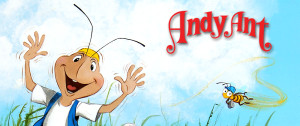Story Writing Hints
By
Gerald D. O’Nan
Author of the
Adventures of Andy Ant Books
(Note: I will try to give you hints and ideas about writing stories using the 8 books in The Adventures of Andy Ant as examples. Having a set of the Andy Ant books available will help you understand the context better, but it isn’t necessary if you have a good imagination.)
The Story Behind the Story – Lawn Mower on the Loose
I have mentioned in earlier hints a bit of the story behind the story of the Swimming Hole Disaster. I’ll try to give you some additional thoughts on other stories to provide a flavor of how simplistic the idea can be and yet it can springboard into an entire adventure.
Each of the Adventures of Andy Ant stories is based on events in my life. If you read the Andy Ant stories and the corresponding “Stories Behind the Stories,” it becomes readily apparent how similar or different the stories are from the events that happened to me. Having a set of the Adventures of Andy Ant will really help you get a more vivid picture of how you can use simple, day-to-day events, to create the foundation for your story. As I mentioned above, the events are merely a springboard into an imaginary adventure.
But you don’t have to only rely on events in your own life. That is why it is important to read a lot of stories, newspapers, and even watch the news on TV. I started writing a book many years ago based on events that happened in the 1930s. I wasn’t even born until the late 1940s so all of the events in this story happened to someone else. Like me, you might have to do a bit of research, but that became part of the excitement. And that excitement turned into that all-important springboard for the adventure.
Lawn Mower on the Loose – While this is the “first” story in the series, it was actually the fourth book that I wrote. My brother, the marketing mastermind of Andy Ant Productions, Inc., had arranged a meeting with a potential publisher. The publisher had some interest in the stories but noticed that Andy Ant and Joey magically appeared on the scene. There was no introductory story to let the reader understand how their friendship came to be.
Therefore, I was instructed to write a story about Andy and Joey meeting for the first time. Lawn Mower on the Loose centers around soccer and the lawn being mowed. Growing up I loved football (gridiron football, not soccer). The story was initially going to be about my dream of playing on a kids’ “junior” football team. However, the publisher thought the story would have broader appeal in an international market if I substituted soccer for football.
As a kid, my “expertise” in gridiron football was as a placekicker. Even though I could kick the ball a good distance, accuracy was lacking. I recall putting on my football helmet and jersey, setting a tee in our large front yard, and kicking the ball to my cousin, Tom, downfield. More often than not, the ball would land in the flowerbed of a retired lady who lived on our property. The flowerbed was her pride and joy. The football landing in her flowerbed destroyed her days and months of work and the joy those flowers brought to her.
On a separate and unrelated occasion, I was tasked with watching a “weed burn” so it didn’t get out of control. The fire seemed small and wasn’t very close to anything important so I decided to go inside the house and watch one of my favorite cartoon shows. Within minutes, the fire whipped up and caught a large cottonwood tree on fire – a tree where my brother and I had built a tree house.
These events formed the basis for Lawn Mower on the Loose. I would encourage you to read that story to see how easily you can change, rearrange, and combine events to create a story. And even more importantly, how you can change the description of the actual event to fit into your fictional story. By the way, the lawn mower in the story was the fire that had occurred in real life; soccer in the story was gridiron football; the flowerbed was the real flowerbed, and just like Joey, I loved to wear the uniform.
Copyright © 2023 by Gerald D. O’Nan All Rights Reserved. No part of this document may be used or reproduced by any means, graphic, electronic, or mechanical, including photocopying, recording, taping, or by any information storage retrieval system without the expressed written permission of the author except in the case of brief quotations embodied in critical articles and reviews.




